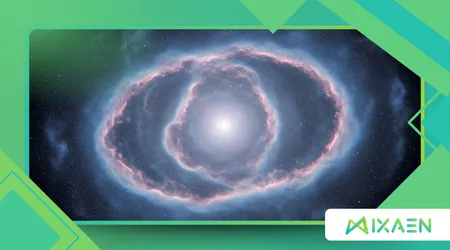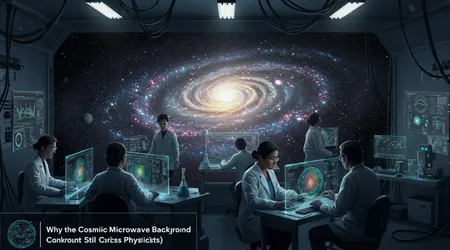Why the Cosmic Microwave Background Still Confuses Physicists

The cosmic microwave background (CMB) is a snapshot of the universe’s oldest light, dating back to the Big Bang.
Anúncios
Discovered in 1964 by Arno Penzias and Robert Wilson, this faint glow, detected by radio telescopes, revolutionized cosmology, cementing the Big Bang theory.
Yet, in 2025, the cosmic microwave background remains a puzzle, raising questions about the universe’s origins, structure, and fundamental physics.
Why does this ancient radiation, uniform yet speckled with tiny fluctuations, still elude full understanding?
This article dives into the mysteries of the CMB, exploring why it continues to challenge physicists and what new discoveries might unravel its secrets.
From its role in mapping the early universe to debates sparked by recent observations, we’ll uncover why the CMB is both a triumph and a conundrum.
The Cosmic Microwave Background: A Relic of the Big Bang
The cosmic microwave background is electromagnetic radiation filling the universe, a remnant of its hot, dense infancy.
When the universe was 380,000 years old, it cooled enough for atoms to form, allowing light to travel freely.
This light, now stretched into microwaves, forms the CMB. Its discovery by Penzias and Wilson, initially mistaken for radio noise, earned them the 1978 Nobel Prize.
This radiation, with a temperature of 2.725 K, is remarkably uniform across the sky. However, tiny temperature fluctuations anisotropies reveal early density variations that seeded galaxies.
These patterns, mapped by missions like NASA’s COBE and ESA’s Planck, provide a blueprint of the universe’s infancy.
++ The Dark Flow Mystery: Is Our Universe Being Pulled by Something Beyond?
Yet, the CMB’s uniformity raises questions. Why is it so consistent across vast distances? The universe’s rapid expansion, called inflation, is one explanation, but alternative theories, like cyclic models, challenge this view.
Recent studies, like those from the Planck Collaboration (2020), show the CMB’s power spectrum aligns with Big Bang predictions. Still, anomalies in its patterns hint at unknown physics. Could these be clues to new forces or dimensions?
Imagine the CMB as a cosmic photograph, capturing the universe’s baby picture. Its clarity is stunning, but some pixels seem out of place, perplexing scientists.

Anomalies in the CMB: Clues or Cosmic Noise?
The cosmic microwave background isn’t perfectly uniform; it contains small irregularities that defy expectations.
One anomaly, the “cold spot,” is a region colder than predicted. Discovered in 2004, it spans 1.8 billion light-years, challenging standard cosmological models.
Another puzzle is the CMB’s “axis of evil,” where low-multipole alignments suggest a preferred direction in the universe.
Also read: Are Time Loops Possible in Curved Spacetime?
This contradicts the expected isotropy, prompting speculation about exotic topologies or observational errors. Are these anomalies real, or artifacts of our instruments?
Recent JWST observations of early galaxies, as noted in a 2025 arXiv paper by Gjergo and Kroupa, suggest massive galaxy formation might influence CMB patterns. This challenges the Big Bang’s timeline, sparking heated debate.
Physicists also study CMB polarization E-modes and B-modes for clues about inflation. B-modes, potentially from primordial gravitational waves, remain elusive, fueling skepticism about inflation’s validity.
Consider a detective analyzing a crime scene: the CMB’s anomalies are like faint footprints, hinting at a larger story but lacking clear context.
The Role of Inflation: A Solution or a Problem?
Inflation, a rapid expansion microseconds after the Big Bang, is thought to explain the cosmic microwave background’s uniformity.
It stretched quantum fluctuations into cosmic scales, creating the seeds for galaxies. But inflation itself is controversial.
The theory solves the “horizon problem” why distant regions of the universe look similar despite no causal contact.
Yet, inflation lacks direct evidence. Predicted B-mode polarization in the CMB, a key test, remains undetected despite efforts by the BICEP program.
Read more: Could the Speed of Light Be Slowing Down Over Time?
Alternative models, like a bouncing universe, propose the CMB’s uniformity results from a contracting phase before expansion. These ideas, though less mainstream, gain traction as anomalies persist.
In 2025, the Simons Observatory continues mapping CMB polarization, seeking inflation’s fingerprints. If B-modes are found, inflation gains credibility; if not, new theories may emerge.
Picture a balloon inflating rapidly: inflation stretches the universe, but without proof, it’s like believing the balloon exists without seeing it.
New Technologies and Future CMB Research
Advanced telescopes like the South Pole Telescope and LiteBIRD are pushing CMB research forward.
These tools measure tiny fluctuations in the cosmic microwave background with unprecedented precision, probing the universe’s earliest moments.
LiteBIRD, launched in 2024, aims to detect B-mode polarization, potentially confirming inflation.
Its sensitivity could reveal primordial gravitational waves, reshaping cosmology. Meanwhile, the Simons Observatory enhances our understanding of CMB anisotropies.
Ground-based experiments face challenges, like atmospheric interference, but space-based missions offer clearer views. The CMB-S4 project, set for 2027, will combine multiple telescopes for detailed maps.
Recent X posts question the CMB’s link to the Big Bang, citing JWST’s early galaxy findings. These debates highlight the need for new data.
Think of CMB research as panning for gold: new telescopes sift through cosmic noise, hoping to uncover nuggets of truth about the universe’s birth.
The cosmic microwave background also informs dark matter and dark energy studies.
Its patterns suggest the universe is 26.8% dark matter and 68.3% dark energy, per Planck 2018 data. Yet, these components remain mysterious, complicating CMB interpretations.
| Component | Percentage of Universe | Role in CMB |
|---|---|---|
| Dark Energy | 68.3% | Drives cosmic expansion, affects CMB uniformity |
| Dark Matter | 26.8% | Influences gravitational clustering in CMB |
| Ordinary Matter | 4.9% | Forms CMB’s thermal radiation |
The CMB and the Multiverse Hypothesis
The cosmic microwave background sparks speculation about the multiverse multiple universes with different physical laws.
Some physicists argue CMB anomalies could be imprints of other universes colliding with ours during inflation.
For example, the cold spot might result from a bubble universe’s interaction, though this remains speculative. No direct evidence supports the multiverse, but the CMB’s oddities keep the idea alive.
Critics argue these theories are untestable, bordering on philosophy. Still, projects like CMB-S4 aim to measure polarization patterns that could hint at multiverse signatures.
In 2025, discussions on X reflect public fascination with the multiverse, though scientists urge caution. The CMB remains a testing ground for bold ideas.
Imagine the CMB as a cosmic canvas: anomalies might be brushstrokes from another universe, but we lack the tools to confirm the artist’s identity.
Why does the cosmic microwave background persist as a mystery? Its uniformity and anomalies challenge our models, pushing the boundaries of physics and imagination.
Conclusion: The CMB’s Enduring Enigma
The cosmic microwave background is a cornerstone of cosmology, yet its mysteries endure. From the cold spot to the axis of evil, its anomalies defy explanation, hinting at new physics or cosmic phenomena.
In 2025, with telescopes like LiteBIRD and CMB-S4, we stand on the brink of breakthroughs. Will these tools confirm inflation or upend the Big Bang model?
The CMB’s faint glow, stretching across 13.8 billion years, holds answers to the universe’s deepest secrets. As we probe its patterns, we’re not just studying radiation we’re unraveling the story of existence itself.
Frequently Asked Questions
What is the cosmic microwave background?
It’s the oldest light in the universe, a microwave glow from the Big Bang, detected everywhere, revealing early cosmic conditions.
Why is the CMB confusing to physicists?
Its uniformity and anomalies, like the cold spot, challenge standard models, suggesting unknown physics or alternative theories like the multiverse.
How does the CMB support the Big Bang?
The CMB’s blackbody spectrum and temperature (2.725 K) match Big Bang predictions, confirmed by missions like Planck in 2018.
